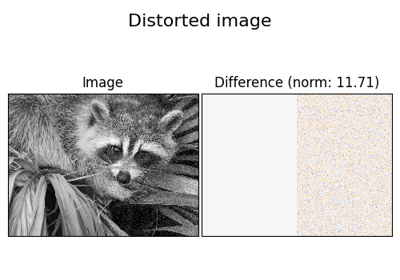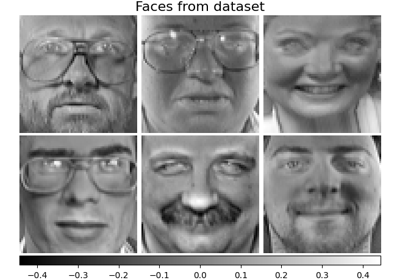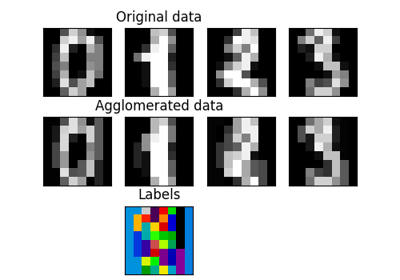备注
Go to the end 下载完整的示例代码。或者通过浏览器中的MysterLite或Binder运行此示例
在线学习面部部分词典#
此示例使用大型人脸数据集来学习构成人脸的一组20 x 20图像补丁。
从编程的角度来看,这很有趣,因为它展示了如何使用scikit-learn的在线API按块处理非常大的数据集。我们的处理方式是每次加载一张图像,并从该图像中随机提取50个补丁。一旦我们积累了500个这些补丁(使用10张图像),我们就会运行 partial_fit 在线KMeans对象MiniBatchKMeans的方法。
MiniBatchKMeans上的verbose设置使我们能够看到在连续调用partial-fit期间重新分配了一些集群。这是因为它们代表的补丁数量太少了,最好选择一个随机的新集群。
# Authors: The scikit-learn developers
# SPDX-License-Identifier: BSD-3-Clause
加载数据#
from sklearn import datasets
faces = datasets.fetch_olivetti_faces()
学习图像词典#
import time
import numpy as np
from sklearn.cluster import MiniBatchKMeans
from sklearn.feature_extraction.image import extract_patches_2d
print("Learning the dictionary... ")
rng = np.random.RandomState(0)
kmeans = MiniBatchKMeans(n_clusters=81, random_state=rng, verbose=True, n_init=3)
patch_size = (20, 20)
buffer = []
t0 = time.time()
# The online learning part: cycle over the whole dataset 6 times
index = 0
for _ in range(6):
for img in faces.images:
data = extract_patches_2d(img, patch_size, max_patches=50, random_state=rng)
data = np.reshape(data, (len(data), -1))
buffer.append(data)
index += 1
if index % 10 == 0:
data = np.concatenate(buffer, axis=0)
data -= np.mean(data, axis=0)
data /= np.std(data, axis=0)
kmeans.partial_fit(data)
buffer = []
if index % 100 == 0:
print("Partial fit of %4i out of %i" % (index, 6 * len(faces.images)))
dt = time.time() - t0
print("done in %.2fs." % dt)
Learning the dictionary...
[MiniBatchKMeans] Reassigning 8 cluster centers.
[MiniBatchKMeans] Reassigning 5 cluster centers.
Partial fit of 100 out of 2400
[MiniBatchKMeans] Reassigning 3 cluster centers.
Partial fit of 200 out of 2400
[MiniBatchKMeans] Reassigning 1 cluster centers.
Partial fit of 300 out of 2400
[MiniBatchKMeans] Reassigning 3 cluster centers.
Partial fit of 400 out of 2400
Partial fit of 500 out of 2400
Partial fit of 600 out of 2400
Partial fit of 700 out of 2400
Partial fit of 800 out of 2400
Partial fit of 900 out of 2400
Partial fit of 1000 out of 2400
Partial fit of 1100 out of 2400
Partial fit of 1200 out of 2400
Partial fit of 1300 out of 2400
Partial fit of 1400 out of 2400
Partial fit of 1500 out of 2400
Partial fit of 1600 out of 2400
Partial fit of 1700 out of 2400
Partial fit of 1800 out of 2400
Partial fit of 1900 out of 2400
Partial fit of 2000 out of 2400
Partial fit of 2100 out of 2400
Partial fit of 2200 out of 2400
Partial fit of 2300 out of 2400
Partial fit of 2400 out of 2400
done in 1.11s.
绘制结果#
import matplotlib.pyplot as plt
plt.figure(figsize=(4.2, 4))
for i, patch in enumerate(kmeans.cluster_centers_):
plt.subplot(9, 9, i + 1)
plt.imshow(patch.reshape(patch_size), cmap=plt.cm.gray, interpolation="nearest")
plt.xticks(())
plt.yticks(())
plt.suptitle(
"Patches of faces\nTrain time %.1fs on %d patches" % (dt, 8 * len(faces.images)),
fontsize=16,
)
plt.subplots_adjust(0.08, 0.02, 0.92, 0.85, 0.08, 0.23)
plt.show()

Total running time of the script: (0分1.836秒)
相关实例
Gallery generated by Sphinx-Gallery <https://sphinx-gallery.github.io> _




